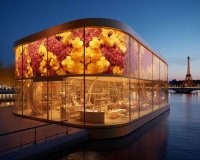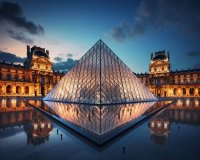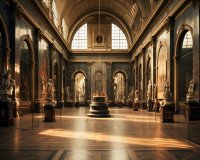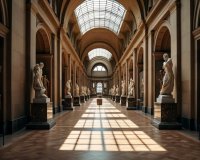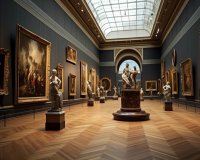The Secrets of The Louvre and French History
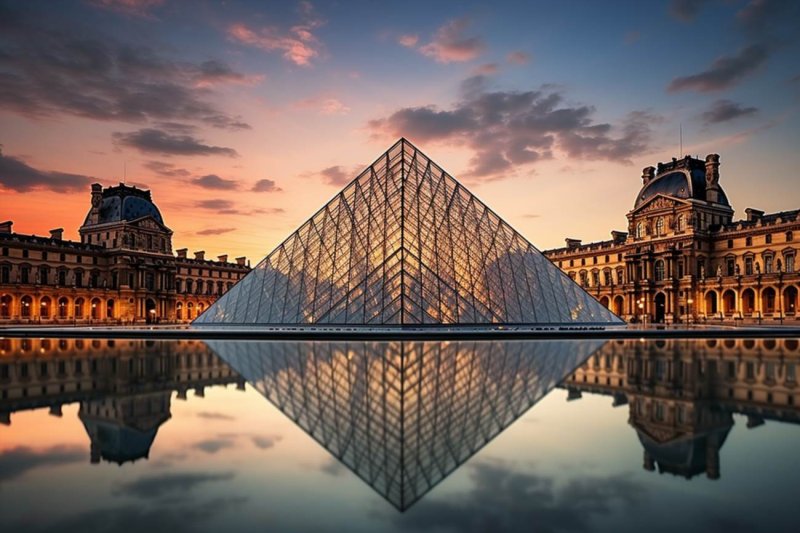
The Secrets of The Louvre and French History
The Louvre Museum, located in the heart of Paris, is one of the world's most renowned cultural institutions. It houses a vast collection of art and historical artifacts that tell the story of both French history and the evolution of art through the ages. In this article, we will delve into the secrets of the Louvre and its deep connection to French history.
The Louvre: A Historical Icon
The Louvre's history is as rich and diverse as the treasures it contains. Originally built as a fortress in the late 12th century by King Philip II, it served as a royal palace for centuries. It wasn't until the French Revolution in the late 18th century that the Louvre was transformed into a public museum, making its incredible collection accessible to all.
One of the most famous parts of the Louvre is the glass pyramid entrance, designed by architect I. M. Pei. This modern addition juxtaposed with the historic architecture of the museum symbolizes the blending of old and new, which is a recurring theme in French history.
The Mona Lisa: A Masterpiece Shrouded in Mystery
No visit to the Louvre is complete without viewing the Mona Lisa, Leonardo da Vinci's iconic painting. This masterpiece is shrouded in mystery and has a history that is as enigmatic as the smile of the woman it portrays, Lisa Gherardini. The painting was stolen from the Louvre in 1911 and was missing for two years before being recovered, adding to its legendary status.
Today, the Mona Lisa is housed in a climate-controlled, bulletproof glass case to ensure its preservation and protection. It continues to captivate visitors from around the world and is a testament to the enduring power of art.
Napoleon and The Louvre
French history and the Louvre are intimately connected through the actions of Napoleon Bonaparte. During his reign as Emperor of France in the early 19th century, Napoleon embarked on a series of military conquests that resulted in the acquisition of countless art treasures. These treasures, known as the Napoleon Loot, found their way to the Louvre.
Some of the most famous pieces in the Louvre, including the Venus de Milo and the Winged Victory of Samothrace, were part of Napoleon's spoils of war. These sculptures, dating back to antiquity, showcase the diversity of the Louvre's collection, ranging from ancient civilizations to the Renaissance.
The French Revolution and The Louvre
The French Revolution was a pivotal moment in both French history and the history of the Louvre. The revolutionaries, inspired by the principles of liberty and equality, transformed the former royal palace into a museum that would be open to the public. This act marked a significant shift in the role of art and culture in society.
The Louvre's collection expanded during this time as artworks from the aristocracy and the Catholic Church were confiscated and placed in the museum. It became a symbol of the people's victory over the monarchy, and the museum's diverse collection reflected the changing political and social landscape of France.
The Louvre Today
Today, the Louvre continues to be a beacon of culture and history. Its collection spans over 9,000 years of history, featuring artworks from around the globe. From the ancient civilizations of Egypt and Mesopotamia to European masterpieces by artists like Rembrandt and Vermeer, the Louvre offers a comprehensive journey through time and artistic achievement.
Visitors can explore the Louvre's many wings and galleries, each dedicated to specific themes and time periods. The museum's commitment to preserving and showcasing the world's artistic heritage ensures that it remains a vital institution for generations to come.
Conclusion
The Louvre Museum stands as a testament to the intertwined history of art and France. Its story is a reflection of the nation's evolution from a medieval monarchy to a republic built on the principles of liberty and equality. The secrets hidden within its walls are a treasure trove of knowledge and beauty, waiting to be discovered by those who visit this iconic museum in the heart of Paris.
Discover the Louvre's Masterpieces: A 2-Hour Guided Tour
Embark on a captivating journey through the Louvre Museum with our expert guide, exploring iconic artworks like the Mona Lisa, Venus de Milo, and Winged Victory of Samothrace.
About the Tour:
Join a small group of art enthusiasts (max 20 people) and meet your guide at the vibrant Kiosque des Noctambules. Over 2 immersive hours, delve into the heart of the Louvre, gaining insights into its extensive collection of over 35,000 artworks.
After the tour, enjoy unlimited exploration of the Louvre's treasures, spanning from 450 BC to the 19th century.
What's Included:
- Guided tour by a licensed expert
- Louvre entry ticket
- Audio headsets for groups over 6 people
Gratuities, hotel pickup/drop-off not included.
Meeting Point:
Meet your guide at the colorful Kiosque des Noctambules above the metro station.
What to Bring:
- Passport or ID card
- Comfortable shoes
Important Information:
All visitors undergo airport-style security. The tour involves walking and climbing stairs; unfortunately, it's not wheelchair accessible due to elevator locations.
Save up to 20% - From $63.97 per person
Customer Reviews:
Overall rating: 4.4/5 based on 397 reviews
Review summary:
- Guide: 4.6/5
- Value for money: 4.2/5
- Service: 4/5
- Organization: 3.3/5
Read what travelers are saying:
Barbara breathed life into each artwork, connecting us with their intentions and stories. Her dedication ensured we saw as much as possible, expertly curating our itinerary. - Thalisa, Italy
Perfect tour! The guided experience is a great way to skim through world history. Our guide handled a difficult situation with professionalism and care. - Greg, Australia
Barbara's exceptional knowledge made the tour enlightening. She effortlessly delved into the stories, significance, and secrets of countless masterpieces. - Anonymous
The Genesis of The Louvre Museum, Paris
The Louvre Museum in Paris, often simply referred to as "The Louvre," is one of the world's most renowned and historic art institutions. Its rich history, spanning centuries, is as fascinating as the priceless art treasures it houses. In this article, we will delve into the genesis of The Louvre Museum, exploring its origins and evolution into the iconic institution we know today.
Early Beginnings
The story of The Louvre Museum begins in the late 12th century. It was originally constructed as a fortress, the "Louvre Castle," by King Philip II. This medieval stronghold was strategically positioned on the right bank of the Seine River, guarding the city of Paris.
Over the centuries, the Louvre Castle underwent several transformations, transitioning from a defensive fortress to a royal palace. It was Charles V in the 14th century who initiated the conversion of the Louvre into a royal residence, marking its shift from a military stronghold to a symbol of royal grandeur.
The Renaissance Era
The true transformation of the Louvre into an art hub took place during the Renaissance period. King Francis I, a patron of the arts, played a pivotal role. He invited the Italian artist and polymath Leonardo da Vinci to his court, and it was da Vinci who brought the renowned masterpiece, the "Mona Lisa," with him to France.
Under the patronage of subsequent kings, the Louvre began to accumulate an impressive collection of art. However, it was King Louis XIV, the "Sun King," who significantly expanded the palace and its collections during his reign in the 17th century.
The Louvre as a Public Museum
The next pivotal moment in The Louvre's history occurred during the French Revolution in the late 18th century. The revolutionary government decided to open the Louvre's doors to the public in 1793, making it one of the world's first public art museums. This move democratized access to art and marked a significant shift in the museum's purpose.
With the opening of The Louvre to the public, its collection continued to grow. Napoleon Bonaparte, who ruled France in the early 19th century, played a significant role in expanding the museum's collection by acquiring art from across Europe during his military campaigns.
Architectural Transformation
Throughout its history, The Louvre underwent various architectural changes and expansions. Perhaps the most famous addition is the glass pyramid entrance designed by architect I. M. Pei, which was inaugurated in 1989. This modern addition added a touch of contemporary elegance to the historic structure.
Modern-Day Louvre
Today, The Louvre Museum is an architectural marvel and a cultural treasure trove. It houses an extensive collection that spans millennia and continents. The museum is divided into various departments, including Egyptian Antiquities, Greek, Etruscan and Roman Antiquities, and of course, the world-famous painting collections.
Visitors from around the globe flock to The Louvre to witness iconic works of art such as the "Mona Lisa," the "Venus de Milo," and countless other masterpieces. The museum's role in preserving and showcasing humanity's artistic heritage cannot be overstated.
Conclusion
The Louvre Museum's journey from a medieval fortress to a world-class art institution is a testament to its enduring significance. It has weathered the tides of history, evolving with the times while preserving its rich cultural heritage. The Louvre's genesis is a story of transformation, innovation, and the enduring power of art to captivate and inspire generations.
Explore the Louvre's Masterpieces with a Skip-the-Line Guided Tour
Discover the iconic Louvre Museum in Paris without the hassle of long lines. Join our expert guide on a comprehensive tour, showcasing not only the famous "Mona Lisa" but also overlooked treasures like the "Great Sphinx of Tanis" and Renaissance masterpieces by Caravaggio and Michelangelo.
Highlights:
- Skip the long lines with fast-track entry
- Admire Da Vinci's "Mona Lisa" and other renowned works
- Explore Greek and Roman antiquities, including the 4,000-year-old "Great Sphinx of Tanis"
- Marvel at sculptures like Michelangelo’s "Dying Slave" and Canova’s "Psyche Revived by Cupid’s Kiss"
- Visit the Apollo Gallery and experience the Louvre’s rich history
After the guided tour, enjoy the freedom to explore the Louvre at your own pace. Whether you want to revisit favorite pieces or discover new ones, the choice is yours.
What's Included:
- Louvre Museum skip-the-line ticket
- Tour guide with in-depth knowledge
- Headset for a clear audio experience
- Gratuities for a hassle-free experience
Meeting Point:
The meeting point is at the Arc du Carrousel, near the Louvre Pyramid. Look for our City Wonders representative in blue attire across the road, past the roundabout, before the entrance to the Tuileries Garden.
Important Information:
- Wear comfortable shoes as the tour involves a fair amount of walking
- Avoid bringing baby strollers, large bags, or oversized luggage
- Arrive 15 minutes before the tour departure time
- Groups of 7 or more may be split into different groups at the meeting point
Book now to secure your spot and pay nothing today. This tour has received rave reviews, with a 4.6/5 rating based on 2648 reviews.
Customer Reviews:
Experience the Louvre through the eyes of delighted travelers:
"I learned wonderful things about the masterpieces in the Louvre from Blerta, the tour guide. Blerta was knowledgeable plus so funny."
"Blerta was my guide, and she was amazing 👏 She had the best tip to see the Mona Lisa."
"We really enjoyed our tour! It was our first time to Paris & I highly recommend doing this tour!!"
Don't miss out on this enriching and enjoyable Louvre experience. Reserve your spot now!
The Impact of Art on the French Revolution in Paris
The French Revolution, one of the most significant events in world history, had a profound impact on not only politics and society but also on the arts. In this article, we will explore how art and the French Revolution intersected in the vibrant city of Paris during this tumultuous period.
Art as a Reflection of Social Change
During the late 18th century, Paris was a hotbed of intellectual and artistic activity. Artists and writers were inspired by the ideals of the Enlightenment, which emphasized reason, liberty, and equality. As tensions simmered in the years leading up to the French Revolution, artists began to use their craft to reflect the changing social and political landscape.
One of the most famous works of art from this period is Jacques-Louis David's painting, "The Oath of the Horatii." This neoclassical masterpiece depicted the story of three Roman brothers pledging their loyalty to the state, symbolizing the call for unity and sacrifice in revolutionary France. David's work captured the revolutionary spirit and served as a rallying cry for the masses.
Propaganda and Political Art
As the Revolution progressed, art became a powerful tool for propaganda. The government, especially during the radical phase of the Revolution, sought to use art to convey its messages and ideals. The Committee of Public Safety, led by Maximilien Robespierre, commissioned artists to create works that celebrated the virtues of the Republic and vilified its enemies.
The most famous example of such propaganda art is the painting "The Death of Marat" by Jean-Louis David. It depicted the assassination of the revolutionary journalist Jean-Paul Marat, portraying him as a martyr for the revolutionary cause. The painting was used to stir up emotions and fuel the fervor of the revolutionaries.
Artistic Expression Amidst Chaos
While some artists aligned themselves with the revolutionary government, others used their talents to document the chaos and upheaval of the time. Francisco Goya's etchings in his "The Disasters of War" series, though depicting events in Spain rather than France, captured the horrors of war and the human cost of political upheaval. These works served as a stark reminder of the consequences of revolution.
Paris also saw the rise of political clubs and societies, where artists and intellectuals gathered to discuss ideas and promote revolutionary principles. The Jacobin Club, for instance, became a hub for political discourse and artistic expression. It was here that artists like Charlotte Corday, known for her assassination of Jean-Paul Marat, were inspired to take action.
Art in the Aftermath
As the French Revolution evolved and eventually gave way to the Napoleonic era, the role of art continued to evolve. Napoleon Bonaparte, himself a patron of the arts, sought to use art to legitimize his rule and reinforce the idea of a new French empire. The Arc de Triomphe and the Louvre Museum, with its extensive art collections, are lasting examples of this effort.
In conclusion, the French Revolution was a time of immense change and upheaval in Paris, and art played a crucial role in reflecting, promoting, and critiquing the events of the era. It served as a mirror to society, capturing the hopes, fears, and ideals of the time. From neoclassical masterpieces to political propaganda, art in Paris during the French Revolution was both a product of its time and a catalyst for change.


